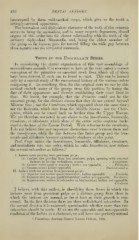Page 406 - My FlipBook
P. 406
41 G JJESTAL ANAT03IY.
interrupted by three well-marked cnsps, Mliicli give to the tooth a
strongly-serrated appearance.
The heterodont and diphyodont character of the teeth of this cetacean
serves to bring the anomalous, and in many respects degenerate, dental
organs of this order into the closest relationshi}) with the teeth of the
ordinary diphyodont ^Mammalia, and, being the oldest member of
the group so far known, goes far toward filling the wide gap between
these aquatic and the terrestrial mammals.
Teeth of the Unguiculate Series.
In considering the dental organization of this vast assemblage of
mammiferous animals it is necessary to have at the very outset a correct
conception of the primitive or ancestral stock from which all of them
have been derived, if such can be found to exist. This can be learned
only by a careful study of the successional history of the various orders
composing it. In searching, then, for this original stem we can by this
method exclude many of the groups from this position by fixing the
date of their appearance, and thereby establishing their exact limit in
time. We know, for example, that the Primates could not be the
ancestral group, for the obvious reason that they do not extend beyond
Miocene time ; nor the Carnivora, which appeared about the same time;
nor the Rodentia, which date from the Middle Eocene ; nor the Cheir-
optera, which can be traced back no further than the Upper Eocene.
AVe are therefore restricted in our choice to the insectivores, lemuroids,
creodonts, or tillodonts, which alone of the entire series continue back-
ward to the base of the Eocene Period. AVith reference to the creodonts,
I do not believe that any important distinctions exist between them and
the insectivores, while the line between this latter group and the lem-
uroids and tillodonts becomes extremely shadowy at this point.
Prof. Cope unites the insectivores, lemuroids, tillodonts, creodonts,
and tfeniodonts into one order, which he calls Bunotheria, and defines
the several sub-orders as follows : ^
I. Incisor teeth groAvinc: frnm persistent pnlps:
[a) Canines also growing from less persistent pulps, agreeing with external
incisors in liaving niolariform crowns 'Jcrniodmita.
[b) Canines riulimental or wanting ; hallux not opposable .... Tillodonta.
[c) Canines none ; hallux opposable Daubenton ioklea.
II. Incisor teeth not growing from persistent pulps:
(") Superior true molars quadritubercular; hallux opposable . . Pro
(c) Superior true molars tr'.tubercular or bitubercular; hallux not opposable.
Creodoida.
I believe, with this author, in classifving tliose forms in which the
incisors grow from jjersistent pulps as a distinct group from those in
which the incisors are normal, as far at least as their growth is con-
cerned. In the first division there are three well-defined sub-orders. In
the second division it is extremely questionable whether more than two
sub-orders should be made. If we use the opposable and non-opposable
condition of the hallux as a character, we Avill have two perfectly natural
' Proceedings Academy yutural Sciences Phllada., 1883.


